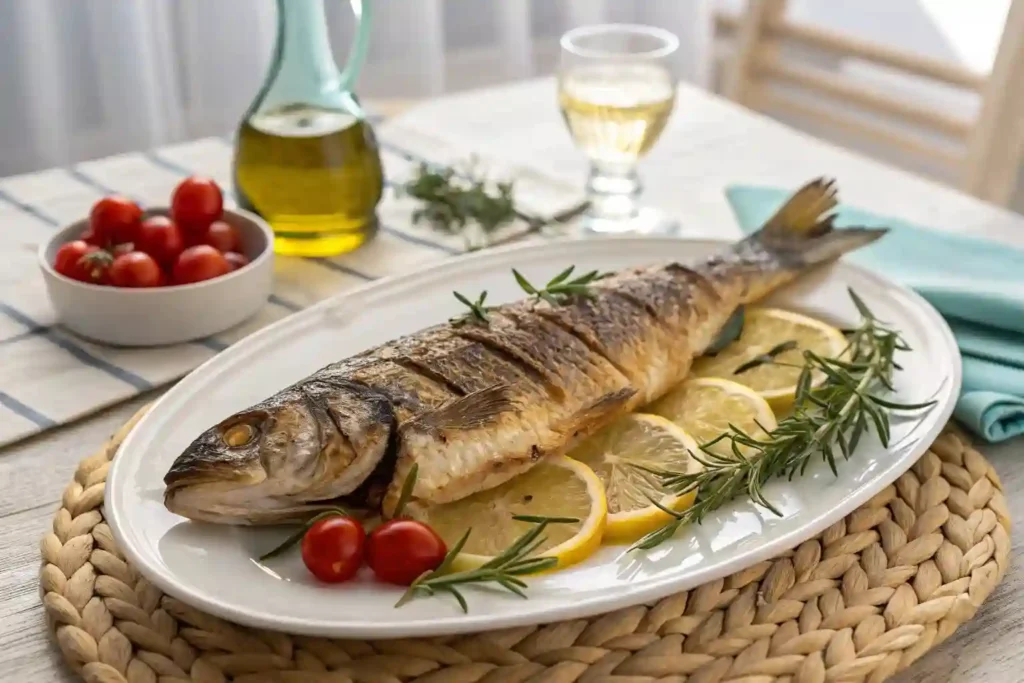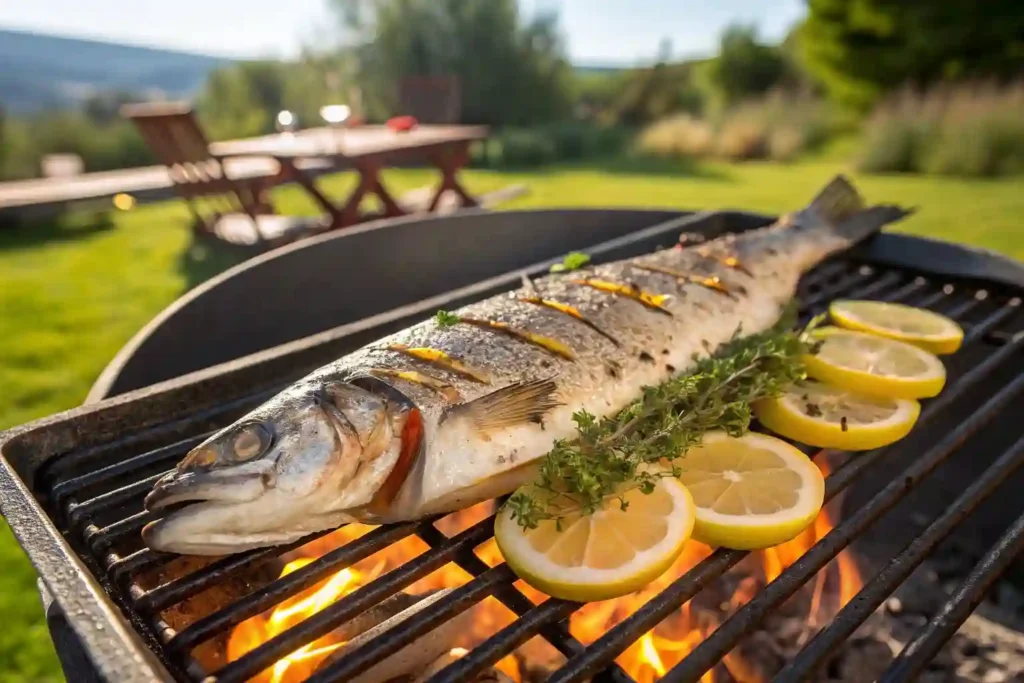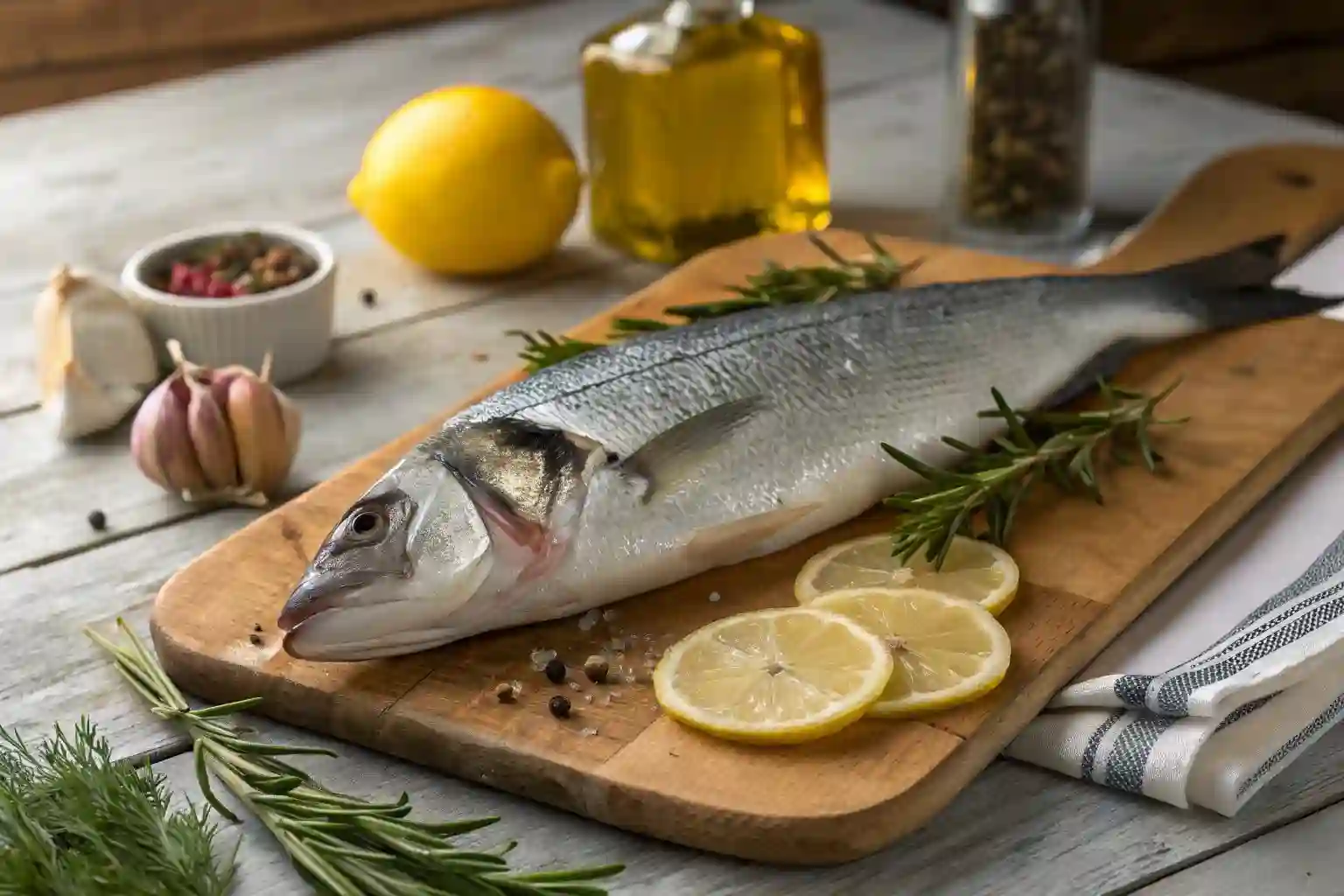Cooks and seafood lovers cherish branzino, also known as European sea bass, for its delicate flavor and versatility. Whether you’re a seasoned chef or a home cook looking to try something new, mastering a branzino recipe can elevate your cooking game. In this guide, we’ll explore everything you need to know about branzino, from its origins to the best ways to prepare and enjoy it.
Table of Contents
What is Branzino fish?
Understanding Branzino as a Fish
Branzino, also called European sea bass, is a saltwater fish native to the Mediterranean Sea and parts of the Atlantic Ocean. Its delicate flavor and flaky texture make it a popular choice for a variety of dishes, including the classic branzino recipe. This fish is often served whole, which enhances its presentation and helps retain its natural moisture during cooking.
Branzino is also known by other names, such as European sea bass or loup de mer in French. Its versatility in cooking and its ability to pair well with a variety of flavors make it a favorite in Mediterranean cuisine.
Why Branzino is Popular in Culinary Circles
Branzino is beloved by chefs and home cooks alike for its versatility. Its mild flavor allows it to pair well with a wide range of seasonings and cooking methods. Whether you’re preparing a simple grilled branzino recipe or experimenting with bold Mediterranean flavors, this fish adapts beautifully to your culinary creativity.
Additionally, branzino is often served whole, which not only enhances its visual appeal but also helps retain its moisture and flavor during cooking. Its delicate texture and ease of preparation make it a go-to choice for both professional chefs and home cooks.
Why Choose Branzino for Your Next Meal?
Nutritional Benefits of Branzino
A branzino recipe isn’t just delicious—it’s also packed with health benefits. Branzino is a lean source of protein, making it an excellent choice for those looking to maintain a healthy diet. It’s also rich in omega-3 fatty acids, which support heart health, brain function, and reduce inflammation.
Additionally, branzino is low in calories and saturated fat, making it a guilt-free option for seafood lovers. It’s also a good source of essential vitamins and minerals, such as vitamin D, selenium, and potassium.
Flavor Profile and Versatility
The mild, slightly sweet flavor of branzino makes it a versatile ingredient in the kitchen. Whether you’re preparing a roasted branzino recipe with lemon and herbs or grilling it with Mediterranean spices, you can adapt this fish to suit any palate. Its tender, flaky texture ensures that every bite is a delight.
Preparing Branzino for Cooking
Cleaning and Prepping the Fish
Before you start cooking branzino, it’s essential to prepare it properly. If you’ve purchased a whole fish, you’ll need to clean and gut it. Many fish markets and grocery stores offer pre-cleaned branzino, but if you’re doing it yourself, follow these steps:
- Scale the Fish: Use a fish scaler or the back of a knife to remove the scales. Work from the tail to the head, rinsing the fish under cold water as you go.
- Gut the Fish: Make a small incision along the belly and remove the internal organs. Rinse the cavity thoroughly to remove any remaining blood or debris.
- Trim the Fins: Use kitchen scissors to trim the fins for a cleaner presentation.
Once cleaned, pat the fish dry with paper towels. A dry surface ensures a crispy skin when cooking.
Essential Ingredients for a Perfect Branzino Recipe
To bring out the best in branzino, you’ll need a few key ingredients. These staples enhance the fish’s natural flavor without overpowering it:
- Olive Oil: A high-quality extra virgin olive oil adds richness and helps achieve a golden, crispy skin.
- Lemon: Fresh lemon juice brightens the dish and complements the fish’s mild flavor.
- Herbs: Popular choices include rosemary, thyme, parsley, and dill. These herbs infuse the fish with aromatic flavors.
- Garlic: Minced or sliced garlic adds depth and a hint of spice.
- Salt and Pepper: Simple seasonings like sea salt and freshly ground black pepper are essential for enhancing the fish’s taste.
Optional ingredients like capers, cherry tomatoes, or white wine can add complexity to your branzino recipe.
Top Branzino Recipe to Try

Classic Oven-Roasted Branzino
Oven-roasting is one of the most popular ways to prepare branzino. This method allows the fish to cook evenly while retaining its moisture and flavor. Here’s a simple recipe to get you started:
Ingredients:
- 1 whole branzino (cleaned and gutted)
- 2 tablespoons olive oil
- 1 lemon (sliced)
- 2 sprigs of rosemary
- 2 cloves of garlic (sliced)
- Salt and pepper to taste
Instructions:
- Preheat your oven to 400°F (200°C).
- Place the branzino on a baking sheet lined with parchment paper.
- Drizzle olive oil over the fish and season it with salt and pepper.
- Stuff the cavity with lemon slices, rosemary, and garlic.
- Roast the fish for 20-25 minutes, or until the flesh is opaque and flakes easily with a fork.
- Serve with a side of roasted vegetables or a fresh salad.
Grilled Branzino with Lemon and Herbs

Grilling branzino is another fantastic option, especially during the summer months. The smoky flavor from the grill enhances the fish’s natural taste.
Ingredients:
- 1 whole branzino (cleaned and gutted)
- 2 tablespoons olive oil
- 1 lemon (halved)
- 2 sprigs of thyme
- Salt and pepper to taste
Instructions:
- Preheat your grill to medium-high heat.
- Rub the branzino with olive oil and season it with salt and pepper.
- Stuff the cavity with thyme and a few lemon slices.
- Place the fish on the grill and cook for 5-7 minutes per side, or until the skin is crispy and the flesh is cooked through.
- Squeeze fresh lemon juice over the fish before serving.
Tips for Cooking Branzino Perfectly
Cooking branzino to perfection requires attention to detail and a few expert tips. Whether you’re roasting, grilling, or pan-searing, these techniques will help you achieve the best results.
How to Achieve Crispy Skin
One of the highlights of a well-cooked branzino is its crispy, golden skin. Here’s how to achieve it:
- Dry the Skin Thoroughly: Before cooking, pat the fish skin dry with paper towels. Moisture on the skin can prevent it from crisping up.
- Use High Heat: Whether you’re grilling or pan-searing, high heat is essential for crisping the skin. Preheat your grill or skillet to ensure even cooking.
- Don’t Overcrowd the Pan: If you’re pan-searing, cook one fish at a time to allow the skin to crisp evenly.
- Avoid Flipping Too Soon: Let the fish cook undisturbed on one side until the skin is golden and crispy. Flipping too early can cause the skin to stick to the pan or grill.
Common Mistakes to Avoid
Even experienced cooks can make mistakes when preparing branzino. Avoid these common pitfalls to ensure a flawless dish:
- Overcooking the Fish: Branzino cooks quickly, so keep an eye on it to prevent the flesh from becoming dry. The fish is done when the flesh is opaque and flakes easily with a fork.
- Using Too Many Ingredients: Branzino’s delicate flavor can be overwhelmed by heavy sauces or excessive seasonings. Stick to simple, fresh ingredients that enhance the fish’s natural taste.
- Skipping the Resting Period: After cooking, let the fish rest for a few minutes before serving. This allows the juices to redistribute, resulting in a more flavorful dish.
How to Serve and Eat Branzino
Branzino is not only delicious but also a visually stunning dish when served whole. Knowing how to serve and eat it properly can enhance your dining experience.
Do You Eat the Skin of Branzino?
Yes, the skin of branzino is edible and often considered a delicacy when cooked properly. Crispy branzino skin adds texture and flavor to the dish. If you prefer not to eat the skin, it can be easily removed after cooking.
To enjoy the skin, make sure it’s cooked until golden and crispy. If the skin is soft or rubbery, it may not be as enjoyable to eat.
Pairing Branzino with Side Dishes
Branzino pairs beautifully with a variety of side dishes, making it a versatile choice for any meal. Here are some popular options:
- Roasted Vegetables: Serve branzino with roasted asparagus, zucchini, or cherry tomatoes for a Mediterranean-inspired meal.
- Rice or Quinoa: A light, fluffy grain like rice or quinoa complements the fish’s delicate flavor.
- Salads: A fresh green salad with a lemon vinaigrette adds brightness and balance to the dish.
- Potatoes: Roasted or mashed potatoes provide a hearty, comforting side.
For a complete meal, consider pairing branzino with a crisp white wine, such as Sauvignon Blanc or Pinot Grigio.
FAQs About Branzino
Branzino is a popular choice for seafood lovers, but if you’re new to this fish, you may have some questions. Here are answers to the most frequently asked questions about branzino.
How Do You Cook and Eat Branzino?
Cooking branzino is simple and versatile. You can roast, grill, or pan-sear it, depending on your preference. The most common method is oven-roasting, where the fish is seasoned with olive oil, lemon, and herbs, then baked until the flesh is tender and flaky.
To eat branzino, start by removing the skin (if desired) and gently flaking the flesh away from the bones. If the fish is served whole, use a fork and knife to separate the top fillet from the spine, then flip the fish to access the bottom fillet. Be mindful of small bones while eating.
Do You Eat the Skin of Branzino?
Yes, the skin of branzino is edible and often enjoyed for its crispy texture. When cooked properly, the skin becomes golden and flavorful, adding a delightful crunch to the dish. If you prefer not to eat the skin, it can be easily removed after cooking.
For the best results, ensure the skin is dry before cooking and use high heat to achieve a crispy finish. If the skin is soft or rubbery, it may not be as enjoyable to eat.
Is Branzino a Good Fish to Eat?
Absolutely! Branzino is a healthy and delicious choice for any meal. It is low in calories and saturated fat while being rich in lean protein and omega-3 fatty acids. These nutrients support heart health, brain function, and overall well-being.
Additionally, branzino’s mild flavor and tender texture make it a versatile ingredient that pairs well with a variety of seasonings and side dishes. Whether you’re following a Mediterranean diet or simply looking for a nutritious seafood option, branzino is an excellent choice.
What Kind of Fish is Branzino?
Branzino, also known as European sea bass, is a saltwater fish native to the Mediterranean Sea and parts of the Atlantic Ocean. People prize branzino for its mild, slightly sweet flavor and flaky texture. Chefs often serve it whole, making it a popular choice for recipes that highlight its natural taste and presentation.
This fish plays a key role in Mediterranean cuisine, celebrated for its versatility in cooking. Whether roasted, grilled, or pan-seared, branzino adapts beautifully to different preparations and flavor profiles.
Conclusion
In conclusion, the branzino recipe is a simple yet elegant dish that showcases the delicate flavors of this Mediterranean fish. By following the steps outlined above, you can create a meal that is both healthy and delicious. For more seafood inspiration, consider trying Salmon Bites or Seafood Boil Sauce, which can complement your branzino beautifully. Additionally, for a detailed guide on preparing branzino, check out The Mediterranean Dish. Embrace the flavors of the Mediterranean and enjoy this delightful fish dish that is perfect for any occasion. Whether served at a family dinner or a special gathering, branzino is sure to impress your guests with its taste and presentation!

